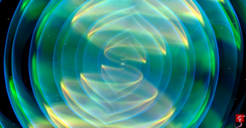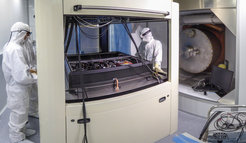Gravitational-wave detectors begin third observation run
AEI researchers expect many more observations in one-year long data taking period
On 1st of April 2019, the twin LIGO instruments, the Virgo detector, and the GEO600 instrument start their third observation run “O3”, which is scheduled to last for one year. The detectors’ sensitivities have been further increased in the past months and previous engineering runs. AEI scientists expect to detect up to dozens of mergers of black holes and further neutron star collisions. LIGO Scientific Collaboration researchers at the Max Planck Institute for Gravitational Physics (Albert Einstein Institute; AEI) in Potsdam and Hannover and at the Leibniz Universität Hannover (LUH) are leading partners in the international gravitational-wave community. They have continued to improve the source modeling, follow-up analyses and the detector technology.

“In the first two observation runs we have detected 10 mergers of binary black holes and one neutron star collision”, say Alessandra Buonanno, director at the AEI in Potsdam, and Karsten Danzmann, director at the AEI in Hannover and at the LUH. “O3 will last longer than previous runs, the detectors are more sensitive than ever before, and we have improved our methods to find and interpret signals so we expect to observe many more signals and learn more about their source’s properties. And who knows what Nature has up her sleeve to surprise us with!”
The estimated rates of binary black hole mergers range from a few events per month to a few events per week. Mergers of neutron stars could be seen as often as once per year and up to once per month. Whether a hitherto undetected merger of a neutron star with a black hole will be observed in O3 is uncertain.
The LIGO detectors transitioned into O3 directly from the 14th engineering run, which began on March 4th. Compared to the best sensitivities reached in O2, their detection horizons for binary neutron star mergers have increased by about 60 Mpc (190 million light-years) to 170 Mpc (550 million light-years) for LIGO, increasing the detection rate by roughly a factor of three to four compared to O2.
O3 will last for an entire year. The Japanese KAGRA detector is expected to join the observation run in late 2019, extending the network by another large detector.
A squeezed-light source from AEI Hannover improves Virgo

The Virgo detector’s detection horizon for binary neutron star mergers is at 50 Mpc (160 million light-years). The detector uses a squeezed-light source developed and built at the AEI Hannover, which is a permanent loan to Virgo. It mitigates quantum noise and thereby improves detector sensitivity especially at higher frequencies.
Faster and more accurate searches for merging black holes and neutron stars
Researchers at the AEI in Potsdam have improved the capabilities of the detector network to observe and infer properties of gravitational-wave sources ahead of O3. For the search and inference of astrophysical, cosmological and gravitational properties of binary black hole and neutron star mergers, they have refined their waveform models, enriching the symphony of gravitational waves by tuning higher harmonics. They have achieved these improvements using a synergy between numerical and analytical solutions of Einstein’s equations of general relativity. They calibrated approximate analytical solutions (which can be computed almost instantly) with precise numerical solutions (which take very long even on powerful computers). This allows the AEI researchers to use the available computing power more effectively and to search more quickly and discover more potential signals in O3, and to determine the nature of their sources. Dedicated to the follow-up analysis of gravitational-wave data, “Hypatia”, a new high-performance computer cluster, of about 9,000 cores was put into operation at the AEI Potsdam recently.
Observations and technology development at GEO600
The GEO600 gravitational-wave detector near Hannover will take part in O3. Many important detector technologies have been developed and tested at GEO600, which are now in use in the LIGO and Virgo instruments and enable their unprecedented sensitivity. This includes high-power laser systems at the heart of the detectors and the monolithic mirror suspensions used for seismic isolation. The British-German instrument GEO600 has been routinely using squeezed-light technology to successfully improve its sensitivity at the upper end of the gravitational-wave spectrum since 2010. In late 2018 it reached a new world record squeezing level of about 6 dB, corresponding to an eightfold increase in observable volume. In O3 both LIGO instruments and the Virgo detector will apply squeezing, although not of the same level.
New: Public alerts
In O3, possible transient gravitational-wave signals (candidates for binary merger signals) identified by the LIGO Scientific and Virgo Collaboration researchers will be made public in near real time. Data about the candidate, such as type of signal, sky position and estimated distance are published via the GCN network, observers will find a quick start guide and a presentation online. Professional and amateur astronomers can schedule follow-up observations of gravitational-wave signals based on information in the public alerts.













